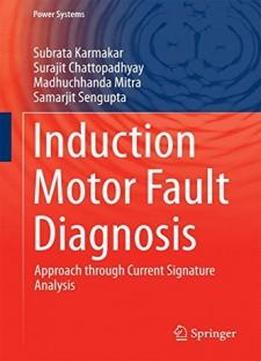
Induction Motor Fault Diagnosis: Approach Through Current Signature Analysis (power Systems)
by Surajit Chattopadhyay /
2016 / English / PDF
5 MB Download
This book covers the diagnosis and assessment of the various
faults which can occur in a three phase induction motor, namely
rotor broken-bar faults, rotor-mass unbalance faults, stator
winding faults, single phasing faults and crawling.
This book covers the diagnosis and assessment of the various
faults which can occur in a three phase induction motor, namely
rotor broken-bar faults, rotor-mass unbalance faults, stator
winding faults, single phasing faults and crawling.
Following a brief introduction, the second chapter describes the
construction and operation of an induction motor, then reviews
the range of known motor faults, some existing techniques for
fault analysis, and some useful signal processing techniques. It
includes an extensive literature survey to establish the research
trends in induction motor fault analysis.
Following a brief introduction, the second chapter describes the
construction and operation of an induction motor, then reviews
the range of known motor faults, some existing techniques for
fault analysis, and some useful signal processing techniques. It
includes an extensive literature survey to establish the research
trends in induction motor fault analysis.
Chapters three to seven describe the assessment of each of the
five primary fault types. In the third chapter the rotor
broken-bar fault is discussed and then two methods of diagnosis
are described; (i) diagnosis of the fault through Radar analysis
of stator current Concordia and (ii) diagnosis through envelope
analysis of motor startup current using Hilbert and Wavelet
Transforms. In chapter four, rotor-mass unbalance faults are
assessed, and diagnosis of both transient and steady state stator
current has been analyzed using different techniques. If both
rotor broken-bar and rotor-mass unbalance faults occur
simultaneously then for identification an algorithm is provided
in this chapter. Chapter five considers stator winding faults and
five different analysis techniques, chapter six covers diagnosis
of single phasing faults, and chapter seven describes crawling
and its diagnosis.
Chapters three to seven describe the assessment of each of the
five primary fault types. In the third chapter the rotor
broken-bar fault is discussed and then two methods of diagnosis
are described; (i) diagnosis of the fault through Radar analysis
of stator current Concordia and (ii) diagnosis through envelope
analysis of motor startup current using Hilbert and Wavelet
Transforms. In chapter four, rotor-mass unbalance faults are
assessed, and diagnosis of both transient and steady state stator
current has been analyzed using different techniques. If both
rotor broken-bar and rotor-mass unbalance faults occur
simultaneously then for identification an algorithm is provided
in this chapter. Chapter five considers stator winding faults and
five different analysis techniques, chapter six covers diagnosis
of single phasing faults, and chapter seven describes crawling
and its diagnosis.
Finally, chapter eight focuses on fault assessment, and presents
a summary of the book together with a discussion of prospects for
future research on fault diagnosis.
Finally, chapter eight focuses on fault assessment, and presents
a summary of the book together with a discussion of prospects for
future research on fault diagnosis.











